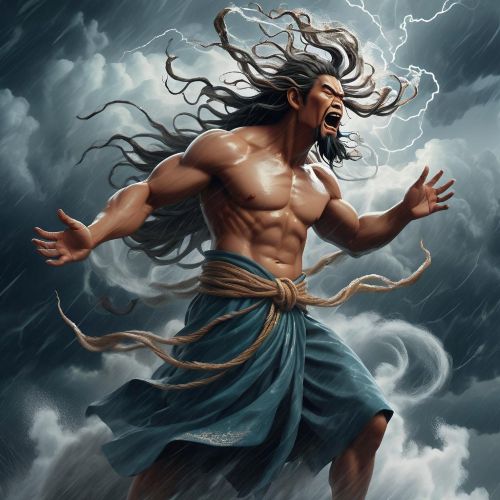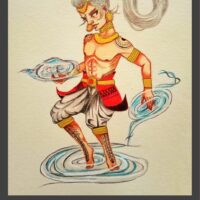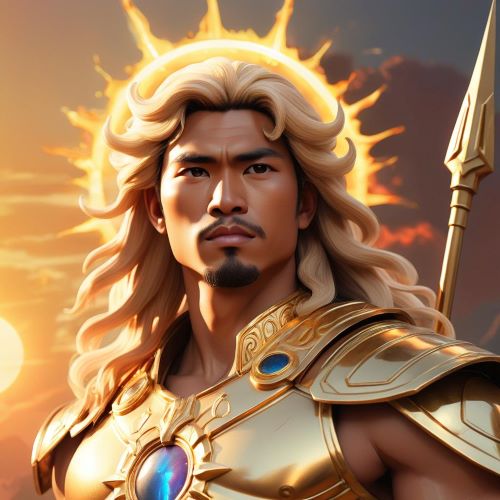
Habagat : God of Winds
Listen
At a glance
| Description | |
|---|---|
| Origin | Philippine Mythology |
| Classification | Gods |
| Family Members | Amihan (Lover), Bathala (Father) |
| Region | Philippines |
| Associated With | Winds, Rains, Silver and Gold |
Habagat
Introduction
In Philippine culture, Habagat is far more than a seasonal weather pattern—he is a mythical force, a symbol of change, and a vital part of the country’s folklore. Representing the southwest monsoon, Habagat is often imagined as a powerful spirit or deity responsible for ushering in the rainy season from June to October. This period, marked by humid winds, torrential downpours, and occasional typhoons, deeply impacts the daily lives of Filipinos. But beyond meteorological effects, Habagat plays a symbolic role in how ancient Filipinos understood nature. He embodies both abundance and adversity—bringing life-sustaining rain to farmlands while also testing the resilience of communities through storms.
Physical Traits
In myth and local art, Habagat is depicted as a towering, elemental being tied to water and air. Unlike more serene deities, Habagat is wild and commanding. Visual interpretations often clothe him in thick storm clouds, with lightning streaking from his eyes and thunder echoing in his voice. His presence is often associated with darkened skies and churning seas. Rather than a gentle breeze, Habagat is imagined as a powerful gust that moves with purpose—either to nourish the earth or to sweep away what no longer serves it. His form mirrors the nature of the monsoon: unpredictable, forceful, and deeply connected to the land.
Family
Habagat does not exist in isolation within Philippine mythology. He is often featured alongside Amihan, the northeast wind, in stories that symbolize the balance of natural forces. In some myths, the two are siblings who alternate dominion over the skies, ensuring a harmonious cycle of wet and dry seasons. In other narratives, they are rivals or even romantic opposites, their interactions bringing about seasonal transitions. While their exact relationship varies, the recurring theme is one of duality—Habagat’s intensity counterbalances Amihan’s gentleness. Some traditions also connect Habagat to Bathala, the supreme deity in Tagalog cosmology, positioning him within a larger family of elemental gods who govern the natural world.
Other names
The name Habagat is widely recognized across the Philippines, especially among Tagalog-speaking communities. However, various ethnolinguistic groups have their own terms or interpretations of this weather deity. Among the Ilocano or Visayan peoples, local names may differ, but the essence of a powerful wind spirit remains consistent. These regional differences show the adaptive nature of folklore—how it shifts to reflect the environment and values of each community. In modern usage, “Habagat” has become the standardized term for the southwest monsoon, blending traditional belief with scientific understanding.
Powers and Abilities
Habagat’s core power lies in his dominion over the southwest wind and the rain it brings. His arrival marks a seasonal shift that farmers and fishermen have relied on for generations. The life-giving aspect of his rains ensures fertile fields and abundant harvests, particularly of rice, the country’s staple crop. But his abilities go beyond agriculture. Habagat can whip up storms that flood rivers, uproot trees, and carve new landscapes. Folktales describe him summoning typhoons or engaging in contests with other wind spirits such as Buhawi, the god of whirlwinds. These stories aren’t just entertainment—they reflect a deep respect for nature’s power and the importance of living in harmony with its rhythms.
Modern Day Influence
Despite his mythological roots, Habagat continues to shape Filipino life in the modern era. The term is now a regular feature in weather forecasts, warning citizens of approaching rains or typhoons. His name is also invoked in literature, music, and visual art as a symbol of resilience and change. In rural areas, some communities still observe rituals tied to the monsoon season, offering prayers for protection or abundance. Schools may cancel classes when Habagat’s rains become too intense, and news broadcasts frequently reference him during natural disasters. Moreover, in discussions about climate change, Habagat often becomes a focal point—his increasing unpredictability a sign of the growing environmental challenges facing the archipelago.
Beyond his literal powers, Habagat holds cultural significance as a metaphor for transformation. He is a figure of both destruction and renewal—reminding Filipinos of nature’s capacity to cleanse, restart, and fertilize. His storms, though sometimes feared, are also welcomed for the nourishment they bring. Artists and writers often portray Habagat as a complex figure: not a villain, but a necessary force that brings growth through struggle. In modern environmental advocacy, he is seen as a symbol of nature’s voice—demanding respect and calling attention to the consequences of ecological imbalance.
Festivals and creative expressions continue to keep his legend alive. In some towns, symbolic re-enactments of his battles with Amihan are performed during seasonal changes. Children learn about him in classrooms, not just through textbooks, but through folk songs and tales passed down from grandparents. Habagat’s myth thus serves as an educational bridge—teaching new generations about the importance of environmental awareness, historical continuity, and cultural identity.
Related Images
Source
WordWeaver. (2013, August 20). Habagat, the Angry God. Retrieved from https://wordweaver32menona.wordpress.com/2013/08/20/habagat-the-angry-god/
Scotty’s Media Team. (2025, March 1). Philippines Seasons: Amihan and Habagat Monsoons. Retrieved from https://www.divescotty.com/underwater-blog/amihan-habagat-monsoon.php
Panahon.TV. (2015, August 18). Understanding “HABAGAT”. Retrieved from https://panahon.tv/beta/v2/web/blog/2015/08/understanding-habagat/
Wikipedia contributors. (2024). Amihan (mythology). In Wikipedia, The Free Encyclopedia. Retrieved May 15, 2025, from https://en.wikipedia.org/wiki/Amihan_(mythology)
Wikipedia contributors. (2024). Amihan. In Wikipedia, The Free Encyclopedia. Retrieved May 15, 2025, from https://en.wikipedia.org/wiki/Amihan
Frequently Asked Questions
What is lorem Ipsum?
I am text block. Click edit button to change this text. Lorem ipsum dolor sit amet, consectetur adipiscing elit. Ut elit tellus, luctus nec ullamcorper mattis, pulvinar dapibus leo.
What is lorem Ipsum?
I am text block. Click edit button to change this text. Lorem ipsum dolor sit amet, consectetur adipiscing elit. Ut elit tellus, luctus nec ullamcorper mattis, pulvinar dapibus leo.
What is lorem Ipsum?
I am text block. Click edit button to change this text. Lorem ipsum dolor sit amet, consectetur adipiscing elit. Ut elit tellus, luctus nec ullamcorper mattis, pulvinar dapibus leo.
What is lorem Ipsum?
I am text block. Click edit button to change this text. Lorem ipsum dolor sit amet, consectetur adipiscing elit. Ut elit tellus, luctus nec ullamcorper mattis, pulvinar dapibus leo.
What is lorem Ipsum?
I am text block. Click edit button to change this text. Lorem ipsum dolor sit amet, consectetur adipiscing elit. Ut elit tellus, luctus nec ullamcorper mattis, pulvinar dapibus leo.












